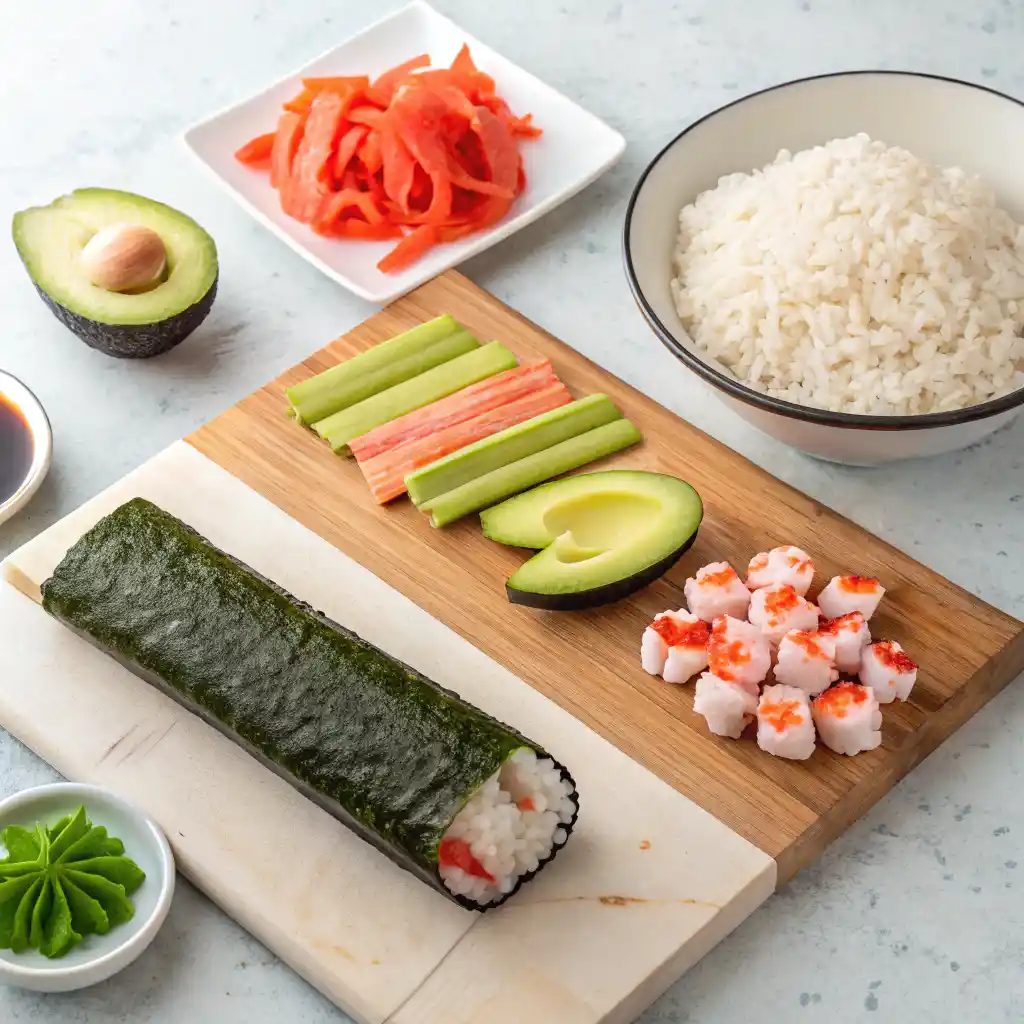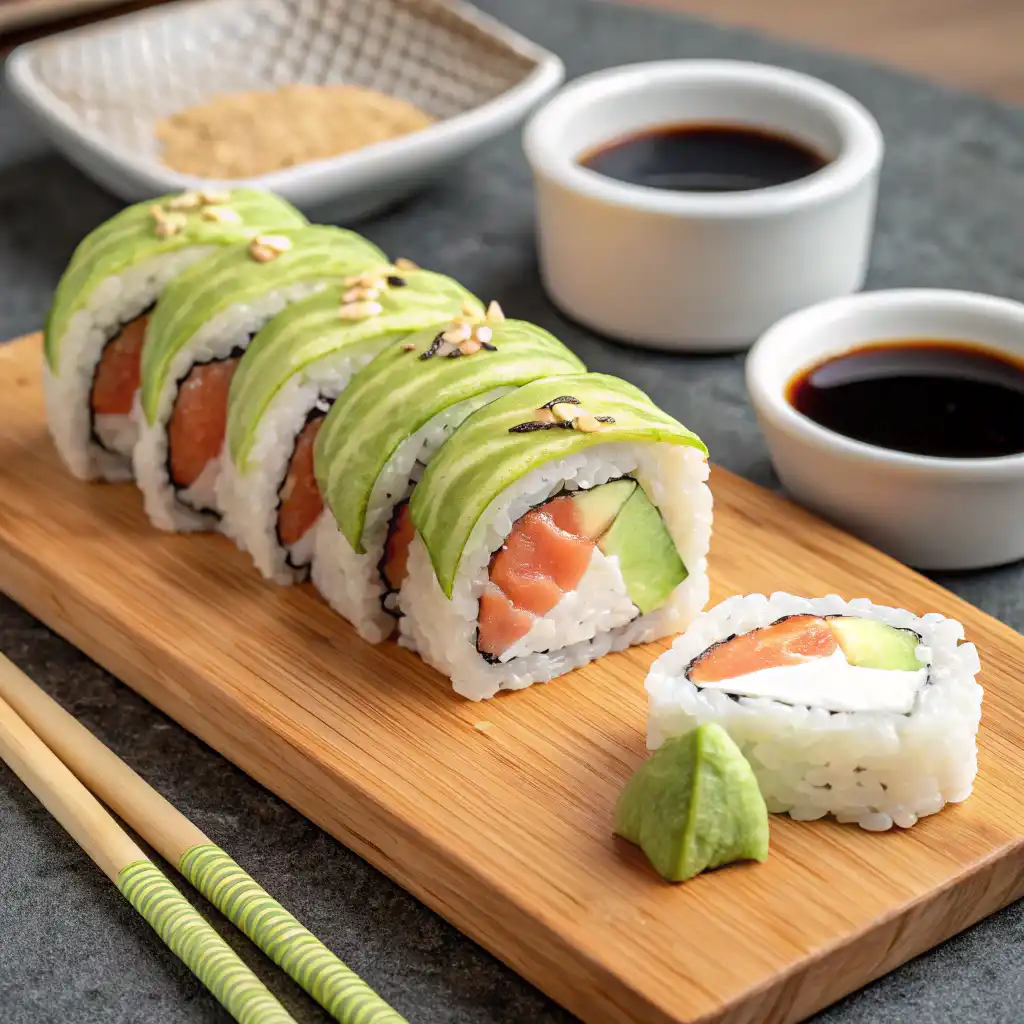Table of Contents
Introduction
Dive into the world of Boston Roll Sushi, where creamy avocado meets succulent poached shrimp and crisp cucumber for a flavor explosion that rivals your favorite sushi restaurant. What makes this roll so addictive is the perfect balance of textures – from the tender rice to the velvety avocado and the sweet pop of shrimp. Did you know that unlike traditional Japanese sushi, the Boston roll is an American creation that’s become a staple on sushi menus nationwide? Even if you’ve never rolled sushi before, this recipe breaks down the process into simple steps that anyone can master in under 30 minutes.
What is Boston Roll Sushi?
Ever wondered why it’s called a Boston Roll Sushi? Despite what the name suggests, this delightful creation doesn’t actually hail from Boston! The moniker likely comes from the poached shrimp (reminiscent of New England’s famous seafood scene) that stars in this American-style roll. As they say, “the way to a man’s heart is through his stomach,” and this roll certainly proves that wisdom with its irresistible combination of creamy avocado, sweet shrimp, and crisp cucumber. Whether you’re a sushi aficionado or a curious newcomer, the Boston Roll is your ticket to sushi satisfaction – no passport required!
Why You’ll Love This Boston Roll Sushi:
A Perfect Balance of Flavors and Textures
Boston Roll Sushi delivers an exceptional harmony of flavors that dance on your palate. The sweetness of poached shrimp perfectly complements the buttery avocado, while cucumber adds a refreshing crunch. What makes this roll truly special is how these simple ingredients create such a sophisticated taste experience. The nori wrapper holds everything together with its subtle oceanic flavor, while perfectly seasoned sushi rice provides the ideal backdrop for these ingredients to shine.
Budget-Friendly Homemade Alternative
Making Boston Roll Sushi at home costs a fraction of what you’d pay at restaurants. A typical restaurant order of 6-8 pieces might set you back $12-15, but this recipe makes 3-4 full rolls (24-32 pieces) for roughly the same price. By purchasing ingredients in bulk and mastering the technique, you’ll save hundreds of dollars annually if you’re a sushi enthusiast. Plus, learning this skill opens the door to endless sushi variations you can create for special occasions or weekly meal prep.
Customizable to Your Taste
One of the greatest joys of making Boston Roll Sushi at home is the ability to customize it exactly to your preferences. Prefer more avocado? Add an extra slice. Want spicier flavor? Mix some sriracha into your mayo for a kick. You can even experiment with adding cream cheese, tempura bits for crunch, or substituting cooked salmon for the shrimp. Unlike our Spicy Tuna Roll which has a more defined flavor profile, the Boston Roll serves as the perfect canvas for culinary creativity. Try making this versatile roll today – your taste buds will thank you!
How to Make Boston Roll Sushi:
Quick Overview
Boston Roll Sushi is surprisingly simple to make at home once you know the secrets. This recipe transforms basic ingredients into restaurant-quality sushi with minimal effort. The most time-consuming part is preparing the rice, but even that becomes effortless with practice. From start to finish, you’ll spend about 40 minutes making these rolls, with most of that time devoted to rice cooking and cooling.
Key Ingredients for Boston Roll Sushi:

- 2 cups sushi rice (Japanese short-grain rice)
- 2½ cups water
- ¼ cup rice vinegar
- 2 tablespoons sugar
- 1 teaspoon salt
- 8 ounces medium shrimp, peeled and deveined
- 1 large avocado, ripe but firm
- 1 cucumber, peeled and cut into thin strips
- 4 sheets nori (seaweed)
- ¼ cup mayonnaise
- 2 tablespoons tobiko or masago (flying fish roe), optional
- Soy sauce, pickled ginger, and wasabi for serving
- Bamboo sushi rolling mat
- Plastic wrap (to cover the mat)
Step-by-Step Instructions:
- Prepare the Sushi Rice: Rinse the rice in cold water until the water runs clear. Transfer to a rice cooker or pot, add water, and cook according to package instructions. While still warm, transfer to a large wooden or glass bowl (avoid metal).
- Make Sushi Vinegar: In a small saucepan, combine rice vinegar, sugar, and salt. Heat gently until sugar dissolves (do not boil). Pour over the warm rice and fold gently with a wooden spoon, being careful not to smash the grains. Fan the rice while mixing to help it cool quickly and develop a glossy finish. Cover with a damp cloth once it reaches room temperature.
- Prepare the Shrimp: Bring a pot of water to a gentle simmer. Add shrimp and cook just until they turn pink and opaque, about 2-3 minutes. Immediately transfer to an ice bath to stop cooking. Once cooled, pat dry and slice each shrimp lengthwise.
- Prepare Fillings: Slice avocado into thin strips. Peel cucumber and cut into thin, matchstick-sized pieces. Place all fillings on a plate for easy access during rolling.
- Set Up Rolling Station: Cover your bamboo mat with plastic wrap to prevent sticking. Place a bowl of water with a splash of vinegar nearby to wet your hands (prevents rice from sticking).
- Assemble the Roll: Place the bamboo mat with the slats running horizontally. Lay a sheet of nori shiny-side down on the mat. With wet hands, take about ¾ cup of sushi rice and spread evenly over the nori, leaving a 1-inch border at the top edge.
- Add Fillings: Spread a thin line of mayonnaise across the center of the rice. Arrange shrimp, avocado, and cucumber in a straight line on top of the rice. If using, sprinkle tobiko on top of the ingredients.
- Roll the Sushi: Use your thumbs to lift the edge of the mat closest to you, and begin rolling forward, applying gentle pressure to create a compact cylinder. Continue rolling until you reach the bare nori border, which will seal the roll. Gently squeeze the completed roll to secure the shape.
- Slice the Roll: With a very sharp knife dipped in the vinegar water, slice the roll into 8 equal pieces. Wipe the knife clean between cuts for clean edges.
- Serve: Arrange the sushi pieces on a plate with small dishes of soy sauce, wasabi, and pickled ginger.
What to Serve Boston Roll Sushi With:
Boston Roll Sushi pairs beautifully with several complementary dishes that enhance the overall dining experience. For a complete Japanese-inspired meal, serve with a small bowl of miso soup and a side of edamame sprinkled with sea salt. A light cucumber salad dressed with rice vinegar and sesame oil provides a refreshing contrast to the rich sushi flavors. For beverages, green tea is traditional, but a crisp Sauvignon Blanc or Japanese beer like Sapporo also complements the delicate flavors wonderfully. If you’re hosting a sushi night, consider offering tempura vegetables or gyoza dumplings as appetizers to round out the meal.
Top Tips for Perfecting Boston Roll Sushi:
Secret #1: Perfect Rice Texture
The foundation of exceptional Boston Roll Sushi is properly prepared rice. After cooking, let the rice rest covered for 10 minutes before adding the vinegar mixture. This allows the grains to firm up slightly, making them easier to work with. When mixing in the seasoning, use a cutting motion rather than stirring to prevent the rice from becoming mushy. The rice should be sticky enough to hold together but still maintain distinct grains.
Secret #2: Temperature Control
Always work with room temperature rice – never hot or cold. Hot rice will create steam inside your roll, making the nori soggy, while cold rice won’t stick together properly. If you need to prepare the rice in advance, keep it covered with a damp cloth at room temperature for up to 4 hours.
Secret #3: Properly Cut Fillings
Cut all fillings to approximately the same length and thickness for balanced flavor in every bite. For shrimp, butterflying them creates a larger surface area that distributes flavor more evenly. For avocado, choose ones that are ripe but still firm – too soft and they’ll turn mushy inside the roll.
Secret #4: Nori Handling
Keep nori sheets in an airtight container until ready to use, as they quickly absorb moisture from the air and become limp. Always place the shiny side down when rolling. If the nori has become slightly stale, passing it quickly over a gas flame can refresh its crispness and enhance its flavor.
Secret #5: Rolling Technique
The key to a tight, professional-looking roll is applying gentle, even pressure as you roll. Too much pressure will squeeze the fillings out; too little will make a loose roll that falls apart when cut. Pull the bamboo mat up and away from you as you roll to create tension on the surface without compressing the fillings.
Secret #6: Knife Skills
Use a very sharp knife for clean cuts. Dip the knife in vinegar water and wipe clean between each slice to prevent rice from sticking. Cut with a single, decisive motion rather than sawing to avoid crushing the roll.
Secret #7: Precision Ratios
Restaurant-quality Boston Roll Sushi maintains specific ratios: rice should be about ¼ inch thick on the nori, and fillings should occupy no more than ⅓ of the roll’s volume. This balance ensures every bite contains the perfect proportion of each ingredient.
Storing and Reheating Tips:
Boston Roll Sushi is best enjoyed fresh, but if you have leftovers, proper storage is crucial. Place uneaten rolls in an airtight container lined with paper towels to absorb excess moisture. Refrigerate for up to 24 hours – beyond this, the rice will harden and the texture will significantly deteriorate. Never freeze assembled sushi rolls as thawing will make them soggy and unappetizing.
When serving leftover sushi, take it out of the refrigerator 15 minutes before eating to allow it to come to cool room temperature, which improves flavor and texture. Sushi is not meant to be reheated, but if the rice has hardened excessively, you can microwave it for 10 seconds, covered with a damp paper towel. This will slightly revitalize the rice without cooking the fillings.
If you want to prepare components ahead of time, cook and season the rice up to 4 hours in advance (keeping it covered with a damp cloth at room temperature), and prepare fillings the day of serving. You can also freeze cooked shrimp for up to one month – thaw overnight in the refrigerator before using in your Boston Roll Sushi.
If you’re enjoying our Boston Roll Sushi, you can’t miss the bold and flavorful Volcano Roll Sushi a deliciously fiery twist on classic sushi
Can I substitute ingredients in a Boston Roll Sushi?
Yes! While traditional Boston Roll Sushi uses poached shrimp, avocado, and cucumber, you can customize it based on your preferences. Cooked salmon or crab stick work well in place of shrimp. If you don’t like avocado, try cream cheese for a similar creamy texture. For a vegetarian version, substitute the shrimp with tamago (Japanese omelet) or marinated tofu. Just maintain a balance of textures and flavors for the best results.
Why does my sushi rice fall apart when rolling?
Sushi rice falling apart is usually due to improper rice preparation. Make sure you’re using short-grain Japanese rice specifically labeled as “sushi rice.” The rice should be rinsed thoroughly until water runs clear, then properly seasoned with sushi vinegar while still warm. If your rice is too dry, it won’t stick together – add a bit more vinegar mixture. If you’re still struggling, try using slightly less rice per roll and applying more even pressure when rolling.
Do I need special equipment to make Boston Roll Sushi at home?
While a bamboo rolling mat (makisu) makes the process much easier, you don’t absolutely need special equipment. You can use a clean kitchen towel or silicone mat as an alternative to the bamboo mat. A sharp knife is essential for clean cuts, but it doesn’t need to be a specialized sushi knife. If you plan to make sushi regularly, investing in a good quality bamboo mat (under $10) and a rice paddle will significantly improve your results and make the process more enjoyable.




